How to Pair Wine with Asian Food
Asian cuisine comprises flavor profiles that run the gamut from sweet, spicy, sour, salty, bitter to umami—with many dishes combining several in one. The expanse and combinations can be intimidating for many when considering how (or even whether) Asian flavors can be enjoyed with wine.
“The biggest misconception about Indian food is that it is fiery and spicy, hence too dominant or unsuitable to pair with wines,” says Sonal Holland, India’s first and only Master of Wine. Additionally, a lot of people think that “Chinese food is strong, oily, ridden with MSG, and not suitable for wine pairing,” notes Bernard Chan, director of wine at the Four Seasons Hong Kong.
Filipino food is often thought to be best paired with sweet wine, since locals tend to have a sweet palate, according to Pierre Angeli Addison, President of the Philippine Sommelier Association.
“[In Singapore,] in a climate well-suited for white / rosé drinking, the bulk of consumers opt for big heavy reds instead,” observes Matthew Chan, beverage director at Michelin-starred Nouri. “I have come to understand that this is due to local palates being used to rich and heavy flavors from the high use of herbs and spices. Interestingly though, the tannins in the wine do not pair well with the spices in the dishes.”
We speak with some of the top sommeliers in their respective regions who share their recommended wine pairings with some of our favorite Asian cuisines.
JAPANESE
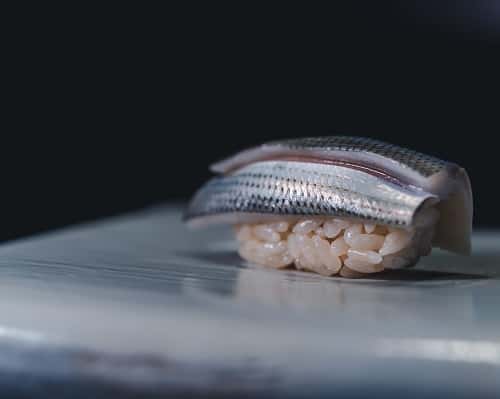
“I think there are two main components in the flavor profiles of Japanese food,” shares Yoshinobu Kimura, co-owner of Sushi M in Tokyo, Japan. “They are dashi (Japanese broth) and citrus fruits.” Kimura, who earned his restaurant management degree at Johnson & Wales University in Rhode Island before working as head sommelier at two-Michelin-starred Narisawa in Tokyo, creates wine pairings based on matching the types of acidity and chemical compounds of wines.
Kimura’s suggestions include:
Kohada (Gizzard Shad) Sushi with Orange Wine
I think Orange Wines tend to have a higher acetic acid in comparison to other white wines. Kohada sushi is prepared with rice vinegar which contains enough acetic acid. Since it is traditionally not cooked, orange wines help remove the unnecessary flavor of the fish.
Ebi Fry (Deep-Fried Shrimp) with Muscadet
Chemically speaking, Muscadet has higher lactic acid versus lower succinic acid. Interestingly, shrimp also has a high ratio of lactic acid and a low ratio of succinic acid. If you take advantage of pairing the same acidity with wines and foods, it will be a unique and precise pairing.
Ikura Don (Salmon Roe Rice Bowl) with Botrytis Wine
This is very unusual but my favorite pairing. Botrytis Wine has much gluconic acid. Believe it or not, the gluconic acid helps connect with fish eggs. Once you sip the botrytis wine while having salmon roe, the wine’s sweetness completely disappears on your palate.
Tekka Maki (Tuna Sushi Roll) with Merlot
This pairing is a pairing of molecular harmonies. Speaking of chemical compounds, beta-ionone has the same compound as the framboise, seaweed, and red grape varieties of Merlot, Syrah and Cabernet Sauvignon.
RELATED: Excellent Sushi and Wine Pairing Concepts To Consider
TAIWANESE
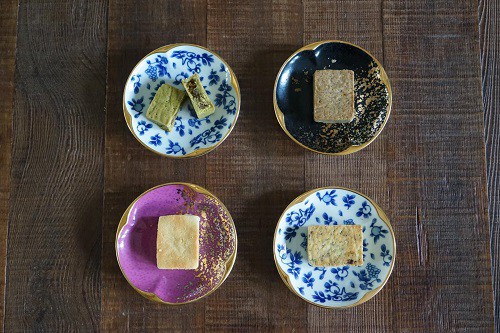
“The predominant Taiwanese flavors are sweet and salty with a bit of spiciness in the south,” shares Thomas Ho, co-founder of Taiwan Academy of Professional Sommeliers, executive director of Taiwan Sommelier, and instructor at National Kaohsiung University of Hospitality and Tourism. “Taiwan has been influenced by Hokkien, Cantonese, Hakka and Japanese cultures, so the cuisine is colorful and flavorful with the use of soy sauce, garlic, ginger and fermented sauces.”
Ho, who is also a sommelier consultant for Liberté Restaurant, adds, “Many people think the best wines to pair with Taiwanese seafood dishes would be dry white or sparkling wines. Actually, the sauces and cooking methods transform the seafood. If soy sauce or a heavy spicy sauce is used, often a light-bodied red wine or high acidic wine would pair better.”
Ho’s recommendations include:
Steamed Red Sea Crab with Vin Jaune (Savagnin)
Winter is crab season in Taiwan and the biologically aged yellow wine, Vin Jaune or Château Chalon, reveals some yeasty aromas like biscuit or cheese, and the wine always pairs well with fully umami seafoods. Also, the acidity can cut through the protein of the crab.
Xiaolongbao (Steamed Dumplings) with Pinot Noir
Xiaolongbao is perhaps the most famous dish from Taiwan, especially from Din Tai Fung restaurant, usually eaten with soy sauce, vinegar and ginger slices. German Pinot Noir features red fruity aromas with a light but balanced body and bright acidity and would make a good combination.
Three Cup Chicken with Black Queen
Three Cup Chicken pairs well with the Black Queen grape, a local variety in Taiwan. The wine shows very intense black fruit flavors with high acid; the wine can match with sugar and fat from every dish, and the bright acid can cut through oily dishes and cleanse the palate.
Pineapple Cake with Golden Muscat
The pineapple cake is one of the most famous souvenirs in Taiwan, and this is great with a local, world-class fortified sweet wine. The Vino Formosa Madeira-style wine from Shu-Sheng Leisure Domaine in Taichung, Taiwan won a gold medal at the International Wine Tasting Competition in France in 2019. If you are ever fortunate enough to visit Taiwan this is a must-try!
RELATED: More on Food Pairing Concepts: This Comfort Food, That Wine
VIETNAMESE
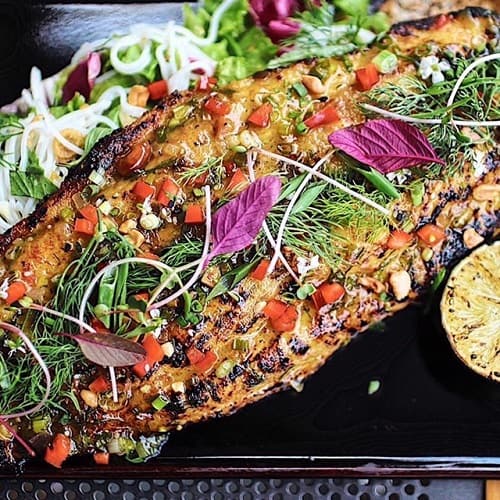
“Sauce is also the backbone of the flavor in many Vietnamese dishes,” shares Nguyễn Khắc Huy, business development manager at Red Apron Fine Wines and Spirits, and co-founder and vice-president of Saigon Sommelier Association. “It’s made by the fermentation process from various ingredients like soy, fermented fish, beans, shrimp, fiddler crab.”
He also believes that tannic and oaked wines are the two major “enemies” to Vietnamese food, which, owing partly to strong influences from Chinese and French cultures, is often rich in garlic, lime, chili, lemongrass, ginger and mints. “They over-amplify the spiciness, bitterness and astringency in the palate.”
Nguyễn’s recommendations include:
Gỏi Bưởi Tôm Thịt (Pomelo Salad with Pork and Prawn) with Sauvignon Blanc
This well-known dish from Central Vietnam has noticeable acidity and freshness from the pomelo with an herbaceous feel. A good wine to pair is youthful, grassy Sauvignon Blanc from Marlborough, New Zealand that matches the acidity in the dish and mellows the umami from the sauce. It also enhances the freshness of the shrimp.
Chả Cá Lã Vọng (Grilled Fish) with Riesling
The river fish is marinated with turmeric, spring onion, heart onion, lemongrass, ginger, and basil then pan-fried. My suggestion is a young Riesling with a tiny amount of residual sugar from Alsace, France. This particular cuisine from Hanoi also has the pronounced flavor of fermented shrimp that requires a laser-focused acidity from Riesling grape wine to refresh the palate.
Bánh Xèo (Crispy Vietnamese Pancake) with Rosé or White Zinfandel
I would pair this with a Dry Rosé from Côte de Provence or an off-dry style White Zinfandel. The freshness and fruitiness from a dry rosé can cope with a crunchy crust, savory fillings and spiciness from herbs and chili. On the other hand, the off-dry white Zinfandel can round off the sweet and sour dipping sauce and reduce the heat from the chili.
Chuối Nếp Nướng (Vietnamese Grilled Banana in Sticky Rice) with sweet Chenin Blanc
This popular southern Vietnamese street snack is best paired with a luscious sweet wine especially Chenin Blanc from Coteaux du Layon, Loire Valley. Moreover, the relatively high acidity in the wine helps balance the flavors of lightly sweet of bananas, salty from sesame seeds mixture, richness from coconut milk combined with a layer of smokiness from charcoal.
RELATED: Wine Styles To Pair With Different Kinds of Pizza
INDIAN
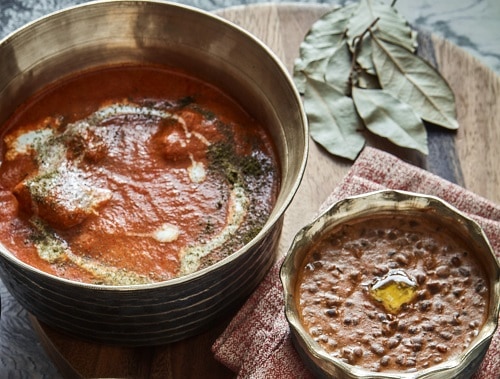
“Indian food is rich, varied and complex. The use of ingredients in regional Indian dishes change every 11 kilometers, so it is hard to compartmentalize Indian cuisine into flavor buckets,” says Sonal Holland, the first and only Indian to have been awarded the title of Master of Wine (currently held by only 409 professionals across 30 countries) and founder and director of her eponymous Sonal Holland Wine Academy. “However, broadly speaking, Indian food flavors and textures are majorly influenced by the cooking methods and can be classified as: smoky foods cooked in the tandoor or grill; creamy as in the case of curries with coconut or cream-based sauces; sour with the predominant use of tomatoes, tamarind or vinegar; spicy with the use of chilies and black pepper; fatty/crunchy textures as in case of fried dishes; and sweet—nearly every Indian claims to have a sweet tooth.”
Here are some of Holland’s recommendations:
Mushroom or Morel Biryani with Pinot Noir
The earthy savory flavors of both morels and Pinot Noir, make the combination complex and intriguing.
Butter Chicken Masala with Sangiovese
The rich tomato-based curry is nicely off-set with a crisp and lively Sangiovese like a Brunello di Montalcino or a Chianti Classico.
Palak Paneer with Rosé
Rosé wines have a crisp and fruity edge which is perfect for off-setting the herbaceous and sometimes bitter finishes in Indian vegetables. Rieslings would work well in this case too.
Yellow Lentil Dal with (Off-dry) Chenin Blanc; Black Lentil Dal with Merlot
Lentils are Indian staples and are best paired with ripe, round, easy-drinking wines that are most compatible with a wide variety of dishes.
FILIPINO
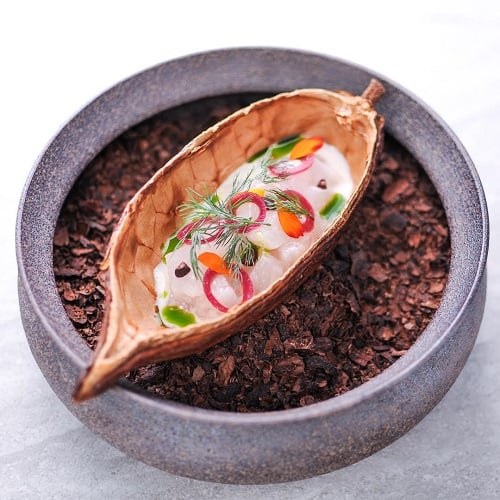
“Filipinos like to eat a combination of sweet, salty and tangy, sometimes even spicy, all at the same time,” shares Pierre Angeli Addison, President of the Philippine Sommelier Association partner at Adviche Hospitality Solutions/ Stvdio Lab (Gallery by Chele), and owner of Ricksha Streetside Tandoor in Manila, Philippines. “Each mouthful is a revelation of flavors and textures.”
Addison’s recommendations include:
Kinilaw (Filipino ‘Ceviche’) with Champagne
With good quality seafood, and the right amount of acidity and richness from the sauce, a vintage Champagne with a higher percentage of chardonnay will work nicely to balance these flavor components. The oak in vintage champagne complements the creaminess of the dish while still keeping the freshness.
Chicken Adobo with Rhone Blend
The nose of a Rhône is distinct and clear. White pepper, lavender, earth, black pepper, bay leaves, red and black fruits. Adobo is umami in a dish. The adobo’s tangy, sweet and salty flavors are complemented by the fruity, savory and spiced profiles I find in a Rhone.
Kare-Kare (Meat and Vegetables in Peanut Sauce) with Touriga Nacional
Portuguese wines are luscious with fairly moderate acidity. Kare-Kare is tricky because you need a mouth-filling wine. The shrimp paste traditionally served with the dish makes it harder to pair with wines and having a super acidic wine tends to give a metallic aftertaste. For this, I go for the boldness of a Touriga because of the dish’s nutty richness and the moderate acid levels coupled with dense fruit balances nicely with the salty, savory flavors of the shrimp paste.
Lechon (Roasted Pig) with Rosé
A fresh, young rosé of Grenache with white pepper and red fruit notes will be great with the melt in your mouth goodness of a well-made lechon. The high acidity and fresh fruit in the wine will cut through the fatty flavors while the weight of Grenache on the palate will complement the pork’s richness.
THAI
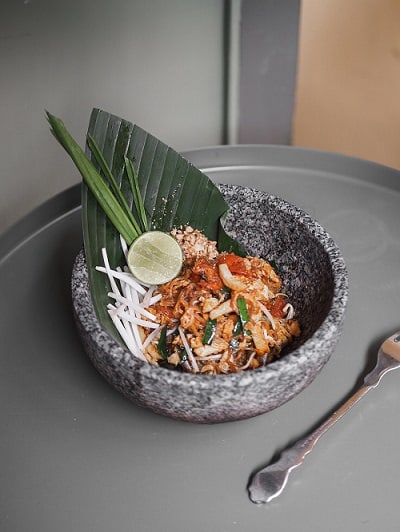
“Thai food has everything your palate wants: salty, sweet, sour, bitter and umami, with an added complexity from the fresh herbs,” shares Ton Tassanakajohn, chef/owner/sommelier of Michelin-starred Le Du, Nusara, Baan and Mayrai Pad Thai Wine Bar, based in Bangkok, Thailand. As an overall wine, he recommends an off-dry Riesling.
Some of Tassanakajohn’s recommendations:
Pad Thai with Orange Wine
The funkiness of Orange Wine blends so well with Pad Thai sauce which is made mainly from tamarind.
Thai Curry with Pinot Noir
Chilled, new world Pinot, especially juicy ones from Sonoma or Napa Valley to go with the different Thai curries.
Thai BBQ and spicy dipping sauce with Malbec
Smokiness and hints of sweetness from the soy sauce and oyster sauce marinade, plus the charcoal and flame—this is heavenly with new a world Malbec from Mendoza, especially Achaval Ferrer.
KOREAN
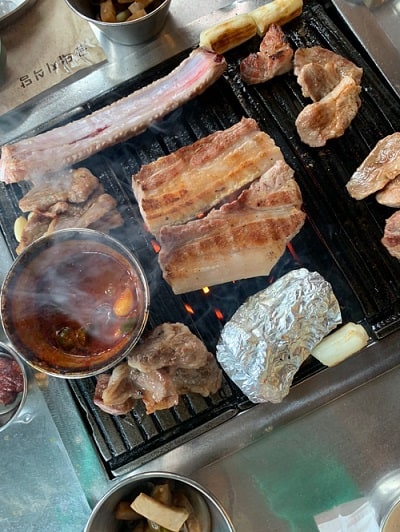
“Korean cuisine captures the essence of season and preserves it. There is simplicity in preparation of ingredients while highlighting the flavors through incorporating elements of fermentation, which brings out the umami,” shares Kyung-moon Kim, Master Sommelier by the Court of Master Sommeliers, one of only 270 in the world, and founder of KMS Imports in New York. “Despite the common belief of Korean food being spicy, I would say otherwise. It all comes down to balance. When there is spice, there is also sweetness or sourness to give equilibrium in overall taste,” the former wine director of Jungsik Seoul and New York adds.
Some of Mr. Kim’s recommendations:
KFC (Korean Fried Chicken) with Champagne
This is the ultimate high-low pairing. Champagne will be my answer, and my personal favorite is Krug Grande Cuvee. It is luscious yet firm, opulent yet restrained and luxurious yet not excessive.
Bibimbap with Gamay
It is a dish that contains myriads of vegetables mixed into a rice bowl with gochujang (red pepper paste). I would pair this dish with Jean-Louis Dutraive’s Fleurie Clos de la Grand’Cour. Gamay is an often-overlooked grape but it is so versatile and food-friendly. Bright and sumptuous red fruits with perfumed floral notes counterbalance the spiciness of gochujang and this medium-bodied wine carries nicely through the overall dish.
Samgyeopsal (Grilled Pork Belly) with Sangiovese
I would pair samgyeopsal with a wine that has sufficient body and moderate tannins that can cut through the richness of pork belly. Sangiovese would be my recommendation, particularly Brunello di Montalcino by Stella di Campalto, my favorite producer of all time.
Yukhoe with Nebbiolo (Barbaresco)
Yukhoe is raw beef marinated with Asian pear, soy sauce, garlic and sesame oil then finished with raw egg yolk on top. This dish has similarity to carne cruda (Piedmonte-style steak tartare) and it will pair with Barbaresco such as Cantina del Pino or Produttori del Barbaresco.
INDONESIAN
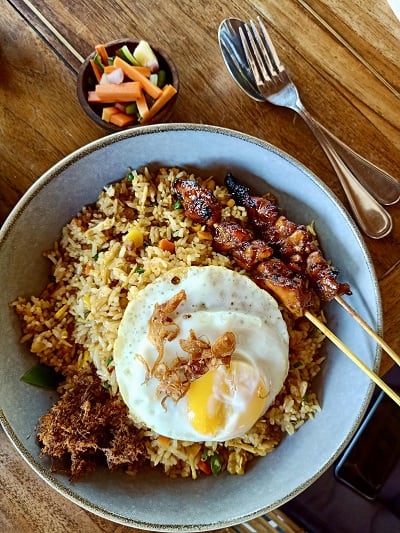
“Indonesia has had so many influences over time ranging from Malaysian, Chinese, Indian, Dutch and Spanish cuisines,” says Ponti Young, certified wine advisor and corporate wine educator, who runs his own consultancy iMust Wine Services in Jakarta, Indonesia. “Overall, however, the key flavor profiles you will note are chilli padi spice, saltiness (especially found in the dried salted fish called ikan asin and an intense shrimp paste known as terasi) and sweetness which mostly comes from palm sugar. Typically, Indonesian cuisine is bold, assertive and tends to have a balance of flavors that lingers.”
“Sometimes I hear Shiraz works with Indonesian food because the spiciness in the Shiraz meets the spiciness in the food. I think the word ‘spicy’ is kind of lost in translation. Give Indonesian chilli spice to Shiraz and you just might send Shiraz running!” shares the Vancouver-trained professional.
Some of Young’s recommendations:
Beef Rendang (Spicy Beef Stew) with Malbec
This dish is Indonesia’s answer to curry, with similar base ingredients such as coconut milk and various spices, just no curry leaves. I had this rich beef dish paired beautifully with a full Malbec from Argentina where the basic theory of rich meets rich pays off. The savory spice with slow-cooked beef marries well with the black fruits and intensity of the Malbec.
Nasi Goreng Kampung (Village-style Fried Rice) with Corvina
There are a gazillion versions of fried rice in Indonesia, but the most popular is the ‘Kampung’ or Village-style. Nasi Goreng Kampung generally comprises of chicken, sunny side up or scrambled egg on fried rice laced with kecap manis (sweet soy sauce). I found a light to medium-bodied red with vibrant acidity complements the savory and slightly sweet fried rice. A Ripasso della Valpolicella or even an Amarone from Veneto with its cherry and raisin tones and bright acidity would do the trick here.
Babi Guling (Balinese-style Roasted Whole Pig) with Rosé
A Dry Rosé made from Grenache grapes always hits the spot for me with its red cherry and strawberry fruit notes to quell the spices, plush red fruit mid-palate and dry finish cleans any lingering flavours and preps you for the next bite.
Martabak Manis (Sweet “Martabak” Pancake) with Touriga Nacional (Port)
An iconic dessert, fillings can vary from a lightly salty cheese to Toblerone chocolate, Nutella, peanuts, matcha, coconut. etc. This medley of sweet, savory and nutty notes pairs nicely with a Port Wine from Portugal. The rich caramel sweetness and toasty rancio notes in an aged port just lends to a decadent close to a meal.
RELATED: 5 Food and Wine Pairing Concepts You Can Try at Home
SINGAPOREAN / MALAYSIAN
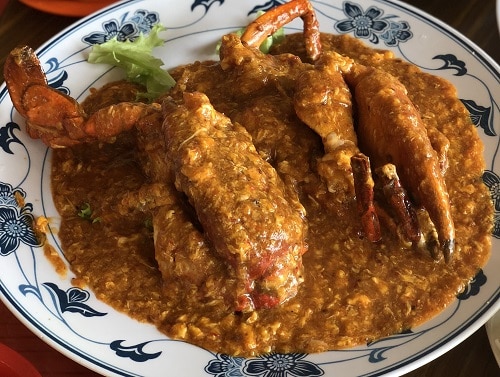
“Singaporean and Malaysian cuisines are strongly influenced by Chinese, Malay and Indian cultures, the main bulk of people that came to settle in the straits in the past,” shares Matthew Chan, Certified Sommelier of the Court of Master and the beverage director at Michelin-starred Nouri and Appetite, based in Singapore. “They share a good use of herbs and spices that mainly dominate the flavor profiles of the Singaporean/Malaysian dishes.”
Chan’s recommendations include:
Chicken Rice with Riesling
There are variations from roasted, to steamed, and even a soy-glazed version, but the star of the dish is actually the rice itself. Rice is cooked with a chicken stock, sometimes chicken fat, garlic, ginger and pandan, giving it a superb aroma, and slight oily texture. Riesling would be the best bet here. Not a fan of spice? A dry Riesling with its high acidity helps to cut through and balance the fat in the dish. If you prefer to have your chicken rice with the aromatic garlic chili that it normally comes with, then pick an off-dry Riesling, with the sweetness helping to balance out the spice.
Chilli Crab with Gewürztraminer
Crabs lathered with a rich sweet-savory tomato-based chili sauce with eggs weaved into it. A Riesling would work well here as well, but I’ve opted for a Gewürztraminer. The slightly lower acidity compared to a Riesling allows the savory richness of the sauce to shine through further, and the aromatic lychee notes of the wine complement that of the dish. An interesting alternative would be a Rotgipfler, native varietal to only the Thermenregion in Austria.
Char Kway Teow with Nebbiolo
Stir-fried flat rice noodles, with soy sauce, blood cockles, Chinese sausage, fish cake and beansprouts. Generally oily, with ‘wok hei’ smoky aromas coming for the heat of the wok, a Nebbiolo would work best here. A varietal that has a natural high acidity, that firstly cuts through the high fat content in the dish, and also brings out the natural sweetness of the cockles. The red fruits on the palate complements the Chinese sausages and smoky aromas as well. Dishes with a heavier use on the dark soy can benefit from a Barolo, but generally a Barbaresco would suffice.
Laksa with Gamay
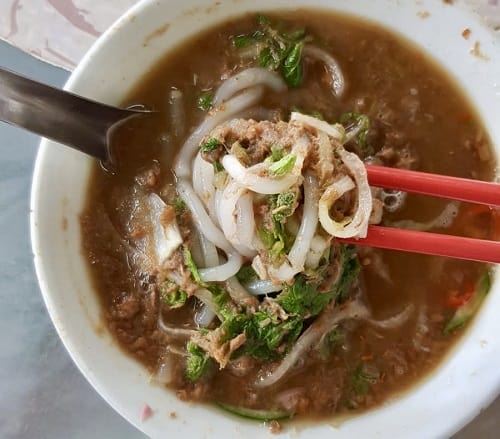
Again, with most of the dishes mentioned here, they come with two or more variations. Here we have one that has a heavier emphasis on coconut milk used in the broth, and the other with tamarind that results with a spicy sour asam. Both dishes are served with wheat or rice noodles and prawns and shrimp. A low tannin varietal like Gamay doesn’t blow the spice to crazy proportions, but yet has the juicy fruit to compliment the big flavors of the dish. Go with a Fleurie for the asam style, its elegance and floral notes complement the ‘sour-ness’ of the broth. The rich bold flavors of the coconut-based laksa warrants a Morgon or Moulin-A-Vent, which brings the same boldness to the pairing.
RELATED: Food and Red Bordeaux Wine Pairing Ideas
CHINESE
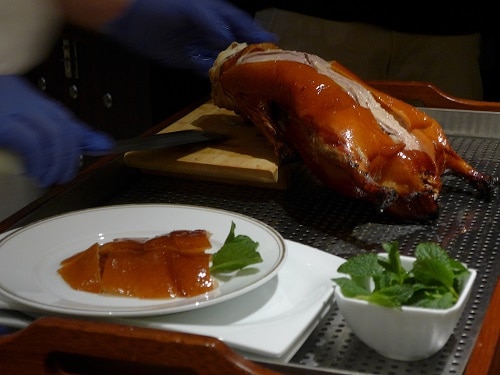
“Cantonese cuisine emphasizes on freshness of the ingredients, often served hot. Sichuan cuisine, of course, is spicy and bold, using a lot of herbs, spices and garlic. Shanghainese cuisine known as Hu cuisine tends to be sweeter as it is known to use a one-to-one soy sauce to sugar ratio. Hokkien cuisine also known as Fujian cuisine features a lighter, sweet and sour flavor profile,” shares Bernard Chan, director of wine at Four Seasons in Hong Kong and senior sommelier of three-Michelin-starred Lung King Heen.
“In general, champagne is good to pair, especially rose champagne,” adds Shanghai-based Caillie Gao, former head sommelier at Jean-Georges Singapore and current head sommelier and senior sales manager of Sarment Boutique Fine Wine China. “Bright acidity can cut down the oily mouthfeel; the complex nose with red berries can accompany Chinese spices very well.”
Chan’s recommendation:
Simmered King Prawn with Pinot Noir
For wok-fried prawns, I would pair a slightly chilled Pinot Noir. The sharp contrasts between the temperatures of the food and wine outline the differences. The Vosne-Romanée Domaine Bertrand & Axelle Machard de Gramont 2017 goes well with simmered king prawns.
Some of Gao’s recommendations:
Dim sum with Chardonnay
A lightly oaked white Chardonnay from Burgundy goes well with dim sum.
Peking Duck with Merlot-Cabernet Franc
A good aged Saint Emilion Bordeaux (mainly Merlot, Cabernet Franc) will be good with Peking duck. It does not shade the roast duck’s smell but has good body and acidity can cut down the fatness and gamey flavor.
Dan Dan Mien with Gewurztraminer
Sichuan-style Dan Dan noodles are spicy, salty and a bit sour as well. I will go with a Gewürztraminer, usually lightly sweet, ripe peach, rose, lychees can help mellow the intensity.
Frequently Asked Questions about Pairing Wine with Asian Food
You are reading “Best Wine with Asian Food Pairings” Back To Top
wine with Asian food, Thai food with wine, sushi and wine pairing, Chinese food and wine matching, soy sauce wine pairing
If you enjoyed this guide, make sure you register to become a Winetraveler for free! You’ll get access to all of our content and interact with other Winetravelers and for travel inspiration around the world. Be sure to follow along with us on Twitter and Instagram as we continue to feature more exciting destinations and wine advice.
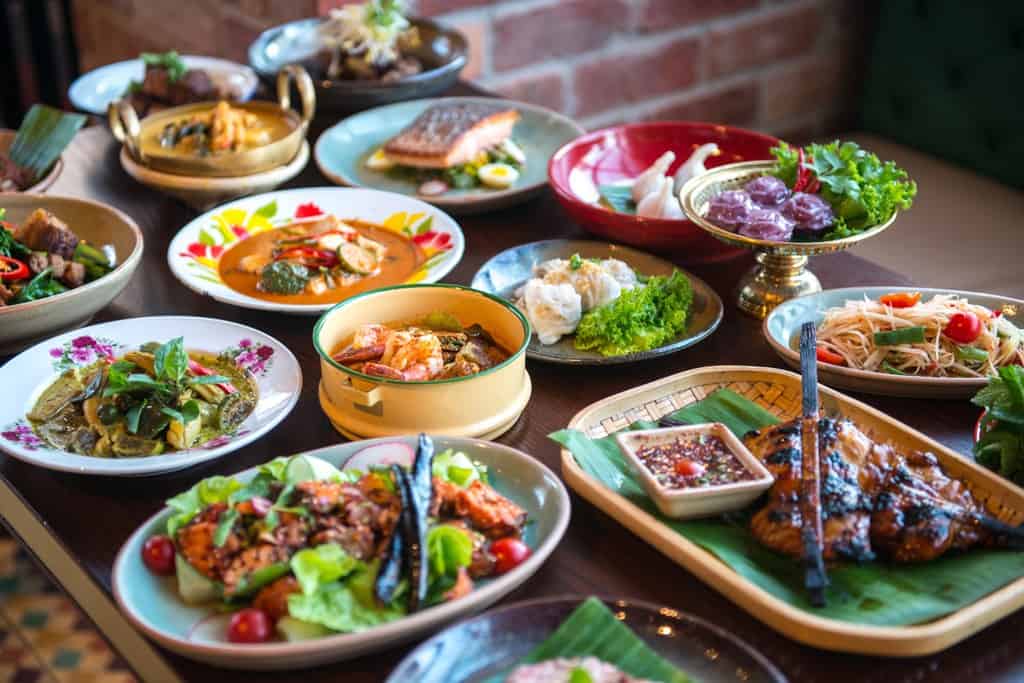
[…] recently wrote an article for Wine Traveler on How to Best Pair Wine with Asian Food, interviewing some of the region’s top sommeliers. I learned A LOT as well, and am definitely […]
[…] an interview with Winetraveler, Thomas Ho said: The predominant Taiwanese flavors are sweet and salty with a bit of spiciness in […]